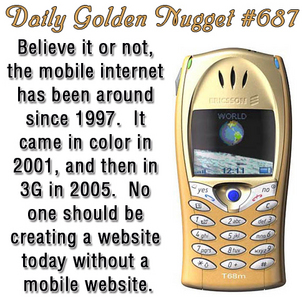 Believe it or not mobile website technology first started to emerge around 1997. At the time the Nokia 9000 Communicator smartphone was perhaps the only reasonably useful device to access the internet through a LCD display. In 2001 Ericsson created the T68 smartphone with the first color display and simple web browser.
Believe it or not mobile website technology first started to emerge around 1997. At the time the Nokia 9000 Communicator smartphone was perhaps the only reasonably useful device to access the internet through a LCD display. In 2001 Ericsson created the T68 smartphone with the first color display and simple web browser.Early smartphone with web capability continued with the PalmOne Treo, BlackBerry 6210 & 7210 in 2003. The Sony Ericsson P910 was released in 2004, and the first 3G phone was the Nokia 6680 in 2005.
While the evolution of the smartphone was taking place there was another early mobile computing technology using palmtop sized computers. Although palmtop computers were first available from Sony, Canon, and Tandy as early as 1989 and 1990, you might recall their common place availability in the mid 1990s with the Windows CE. The more advanced versions of these palmtop computers had PCMCIA cards with wireless antennas to get them online.
Then in 2005 the evolution of the smartphone and the palmtop computer came together with the HTC Universal smartphone with 3G and the Windows Mobile operating system.
The evolution of the smartphones is really what made mobile internet access a reality. All the "smart toys" before 2005 were too expensive for the average user, clunky, and if you owned one you were either a high paid executive or a technology geek.
I briefly explained this history to a colleague of mine at the recent JA Show in New York. He was surprised that mobile internet access was available for so long. Most people believe that mobile internet access was only available in 2007 when Apple released the iPhone.
Those of us in the web programming industry all assumed that 2009, or 2010, oh no, perhaps 2011... ah it must be 2012.... these were all supposed to be the "year of mobile." We assumed that business owners would flock to the mobile technology and embrace the creation of a mobile website.
Certainly many large companies with large budgets were able to create and program their own mobile websites and even smartphone apps, but most businesses simply ignored mobile web browsing as if it would go away.
Sadly, yes, most jewelers have also ignored this emerging technology even though more than 25% of all website traffic to jewelry related websites if coming from a mobile device of some type.
You might have heard that the latest websites can include something called a "responsive design." This is a website design that is able to detect the size of a web browser and reorganize the information on the page to fit that size screen. Since very few people had the money to develop a mobile website, programmers came up with a way to use style sheets to mimic a mobile site.
Don't fool yourself... responsive website design is a good idea but is not a replacement for a mobile website.
Mobile websites are supposed to be faster and more convenient for a mobile user. Give them what they need for whatever location they might be in. The challenge of mobile website design is to figure out what your users actually need while they are out and about.
Responsive websites are nothing more than your full desktop website rearranged to fit a smaller web browser. Large images, large pages, and large bandwidth are all requirements for using responsive designs. Users with unlimited data plans on their phones won't actually care if you have a responsive design or a real mobile site, but those with data plan limitations will think twice before revisiting a responsive website that has tons of large images and slow download times.
At the beginning of 2013 a few internet experts were saying things like "2013 will finally be the year of mobile," but many others also said things like, "mobile is here already."
I will agree with the latter sentiment. Mobile is here. It's been here since 1997. Get on board.








